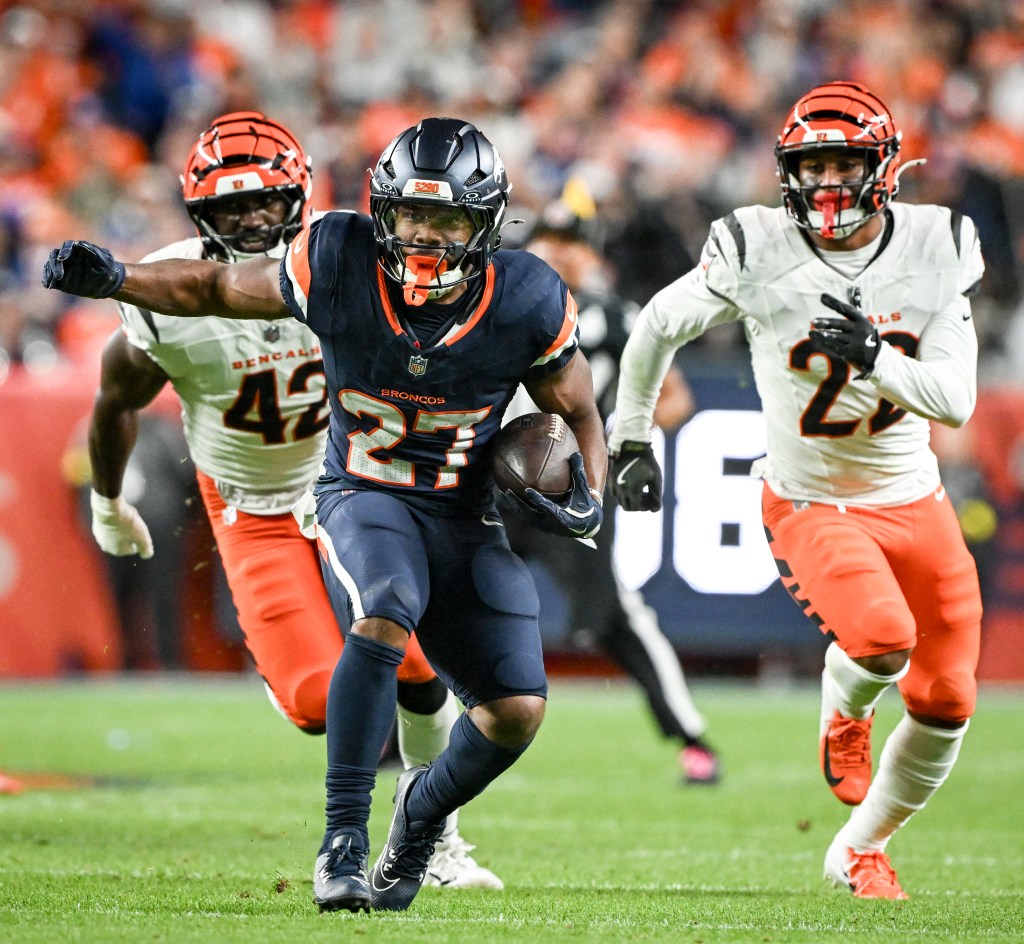The Broncos got back on track with a 28-3 demolition of the Cincinnati Bengals on Monday night at Empower Field. Here are seven thoughts as the Broncos get ready to head off on a two-game road trip:
1. A subtle tweak just might have unlocked the Broncos’ running back pair of J.K. Dobbins and RJ Harvey.
“The rookie and the vet,” All-Pro Broncos right guard Quinn Meinerz said proudly in the postgame locker room when asked about Harvey and Dobbins.
For the first time this season, Denver’s running back production looked like a classic Sean Payton outfit.
The theory is going to be put to the test in more stringent ways against Philadelphia on Sunday and beyond, but an adjustment made before Denver’s 28-3 Week 4 win appears to have paid immediate dividends for the two backs and for Denver’s offense overall.
Payton said after the game that he and running backs coach Lou Ayeni decided they would use Dobbins and Harvey on more of a series-by-series basis rather than rotating them based on the play call.
“I think it helped both of them,” Payton said. “Certainly, it’s easier to call plays. Both of them got into good rhythms and earned hard-fought yardage. Those guys both ran hard.”
Why Broncos’ Sean Payton said his ‘B.S. nose’ went up over Tush Push ban efforts
Dobbins said the change in workflow made a big difference.
“I’m one of those guys where, if I get in a rhythm, if I get consecutive carries, I get better,” the summer free-agent addition said. “As the game goes on, I get better. I’m sure that’s probably every running back. They’ll (all) probably tell you that. So tonight in the second half, that’s what you saw. I think Coach Payton is starting to figure me out, figure RJ out, figure the offensive line out and just the whole offense. He’s figuring it out, and he’s doing a great job of putting us in the right position.
“The series (setup), getting consecutive touches, you see what happens. In (37) games, we never had a 100-yard rusher. That happened tonight because Coach Payton put us in that position.”
Part of what made that possible is Harvey getting more comfortable with the offense and the staff growing to trust him to play in all kinds of mixed-down settings. If you don’t think he can handle certain parts of the play sheet, you can’t leave him in the game for a whole series without calling plays with one arm tied behind your back.
Against the Bengals, everything finally clicked for both.
Dobbins rushed 16 times for 101 yards and caught one pass for 4. Harvey carried 14 times for 58 yards and caught four passes for 40, including a wide-open, walk-in 14-yard touchdown in the fourth quarter.
That’s a grand total of 203 yards and a touchdown on 35 touches between Denver’s two backs.
“It’s a great balance,” Dobbins said. “I’m always in RJ’s corner. I’m always trying to help him and do everything I can to make him be a really good pro. He’s going to keep getting better, and we’re going to help each other in the long run. That’s the only thing that matters, is us getting the win and me helping my young guy.”
Denver had 34 combined completions, sacks and carries last week, and nine of them went for no gain or negative yardage. The Broncos on Monday night had 64 completions and carries (not counting three Bo Nix kneeldowns to end the game), and only three went for no gain or negative yardage.
“It’s the same for running backs as it is for offensive linemen, where you need the reps,” Meinerz said. “There’s constant small tweaks you’re trying to make with footwork, hand placement for the o-line. If the running back is really starting to feel the nickel pressure, then he’s going to understand how he wants to set that block for us. Stuff like that.
“Those are things that, throughout a game, will always kind of change and tweak a little bit. I think we did a great job tonight of executing that.”
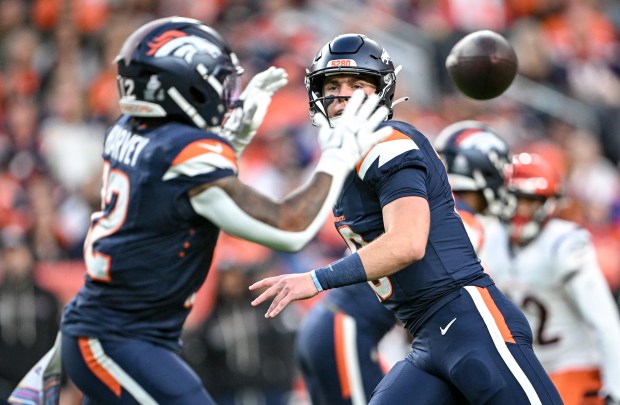 Bo Nix (10) of the Denver Broncos pitches to RJ Harvey (12) during the first quarter against the Cincinnati Bengals at Empower Field at Mile High on Monday, Sept. 29, 2025. (Photo by AAron Ontiveroz/The Denver Post)
Bo Nix (10) of the Denver Broncos pitches to RJ Harvey (12) during the first quarter against the Cincinnati Bengals at Empower Field at Mile High on Monday, Sept. 29, 2025. (Photo by AAron Ontiveroz/The Denver Post)
Payton has a long history of using two backs and doing so effectively. Over 14 seasons in New Orleans — taking out an injury-riddled 2010 — the back with the second-most touches on Payton’s Saints teams averaged 155 per year. From 2017-2020, Alvin Kamara split time with Mark Ingram (2017-18) and Latavius Murray (2019-20) and eclipsed 200 touches every year. In those four seasons, the other back averaged 199.
The Broncos’ pair has a long way to go to reach numbers like that, but this was perhaps the closest to Payton’s two-back ideal that he’s deployed in a game since he’s been the coach in Denver.
One other interesting tweak to the Broncos’ backfield preparation this year: The backs have been spending time during the week in Denver’s offensive line meetings, a new development this season.
“We’ve had a lot more meetings together this year,” Meinerz said. “We’ve sort of alluded to it since training camp. We’re working together more to try to nail down this run game so that way we can be successful. You can see the hard work starting to pay off. …
“It’s great because now they can understand where the ball most likely is going to hit, what kind of combinations we can get into, and what they can do to help set up certain blocks for us.”
2. Want a sign of Bo Nix’s growth? He bailed Sean Payton out of a bad spot late in the first half and delivered a touchdown pass, too.
Nix threw an in-breaker to Courtland Sutton for 8 yards with 17 seconds left in the first half that got Denver down to the Cincinnati 20-yard line, but Sutton was tackled in-bounds, and the Broncos didn’t have any timeouts left.
The Bo Nix Index, Week 4: Quarterback’s decisiveness, footwork buoy win over Bengals
Instead of having to clock the ball on third-and-2 and likely attempt a field goal, however, the Broncos caught a break because Joseph Ossai had lined up offside.
That stopped the clock and allowed the Broncos to huddle with 13 seconds left.
Still, when the Broncos broke the huddle, they were in 01 personnel — no running backs on the field, tight end Evan Engram and four receivers in Marvin Mims Jr., Pat Bryant, Troy Franklin and Courtland Sutton.
Payton indicated he sent a play in, but Nix recognized that they needed something different based on the clock and the personnel in the game.
“Bo kind of bailed me out,” Payton said. “… We don’t really want the play clock to be running, so it is out of bounds or end zone. It was a great call by him, a great throw and catch by Sutton.”
Nix smiled when told after the game how Payton described the sequence.
“It was an interesting situation because we had a good plan and then they got the penalty and that kind of threw us off a little bit as far as if the clock was going to continue to run,” Nix said. “After that, it was down to 13 seconds, and you’ve got to really hurry. That and 12 is about as low as you want to go to catch the ball in bounds and spike it. We decided to get a play to the end zone, and with the personnel we had out there, we just had to make it work.”
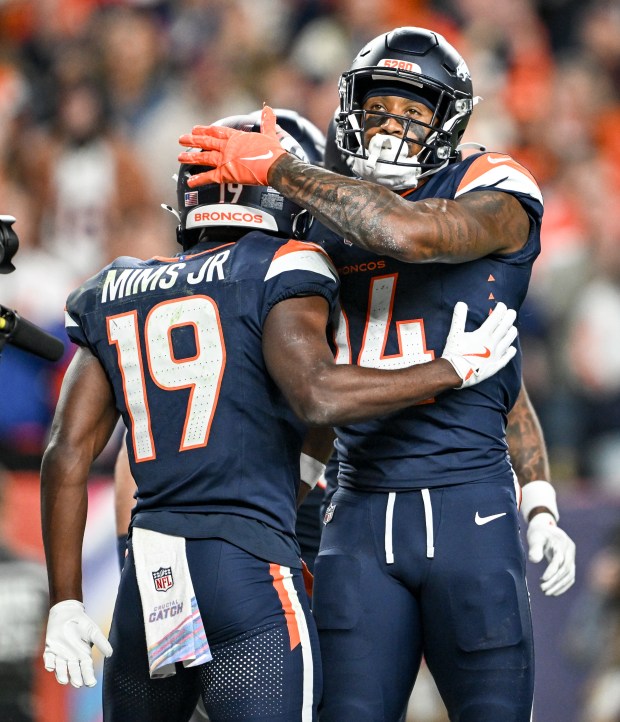 Courtland Sutton (14) of the Denver Broncos celebrates catching a receiving touchdown with teammate Marvin Mims Jr. (19) during the second quarter against the Cincinnati Bengals at Empower Field at Mile High on Monday, Sept. 29, 2025. (Photo by AAron Ontiveroz/The Denver Post)
Courtland Sutton (14) of the Denver Broncos celebrates catching a receiving touchdown with teammate Marvin Mims Jr. (19) during the second quarter against the Cincinnati Bengals at Empower Field at Mile High on Monday, Sept. 29, 2025. (Photo by AAron Ontiveroz/The Denver Post)
Engram was in the slot to the trips side with Sutton No. 2 and Franklin outside. The Broncos basically ran four verticals with the receivers, and Engram bent a crossing route toward the middle of the field. That pulled a linebacker inside just enough for Nix to throw a dart to Sutton up the seam for a touchdown with 8 seconds left in the half.
Looked pretty, even if it wasn’t how the head coach had drawn up the closing sequence from the sideline.
“It wasn’t what I think (Payton) imagined or planned, but it worked out in our favor,” Nix said. “… A little bit of chaos, but we made it work. Find ‘Court’ and throw it to him.”
3. Payton will gladly take this game on his September ledger now that it’s over.
Payton joked in the lead-up to the game that he thought it should be considered an Oct. 1 contest. His rationale: Career numbers. The veteran head coach entered Monday night 30-30 in September, so the win now has moved back above .500.
Payton is now 4-7 in September since arriving in Denver. He’s had just three winning opening months since 2014, a span of 10 seasons. His teams have entered October with a losing record six times in that stretch, and now the Broncos have scratched out level records each of the past two seasons, going 2-2 last year and this fall.
Payton, though, has generally aced October. He’s got a career 50-17 mark in the season’s second month and now heads into a tough start this year at Philadelphia with a 6-3 record as Denver’s head coach.
Another measuring stick as the 2025 schedule pushes into fall: Looking at how Payton’s fared compared to the other head coaches hired before the 2023 season. Frank Reich was fired in Carolina after just one win in 11 games, but the rest are all at interesting points in their tenures.
Here’s the breakdown for Payton, Houston’s DeMeco Ryans, Indianapolis’ Shane Steichen and Arizona’s Jonathan Gannon.
Coach
W-L
Playoffs
Year 3
*Fired
Ryans and Payton are the only two who have made playoff appearances so far, but Steichen’s got the Colts off to the best 2025 start, even after a 27-20 loss Sunday against the Los Angeles Rams. Obviously, every team has its own challenges and advantages when a coach first takes over, but so far Payton’s tenure looks a lot like that of Steichen and Ryans, and in the early going this season, it’s Steichen and then the rest of the group.
4. Jonathon Cooper introduced Nik Bonitto in the post-game locker room like a hype man and referred to him as “the best pass-rusher in the NFL.” The Broncos certainly treated him more like one this offseason than Cincinnati did with star Trey Hendrickson.
Bonitto continued his dominant start to the season, logging 1.5 sacks against the Bengals to push up to 4.5 on the season through four games. He added six more pressures to his ledger in 19 pass rushes, according to Next Gen Stats, and now has at least six in each of Denver’s first four games and 27 total.
Bonitto has racked up 15 “quick” pressures, meaning 2.5 seconds or less, and his 31.4% pressure rate is the highest of any player through four weeks since NGS started tracking pressure data in 2018.
Simply put, he is off to a monster start.
Bonitto’s been playing free and fast since he signed a four-year, $106 million extension on Thursday of Week 1.
He had to wait longer than most to get a contract extension this summer. In fact, his deal got done after every other pass-rusher due for a contract had his situation addressed.
Bonitto acknowledged to The Post last week that some frustration crept in as he watched other players get contracts done. The list included guys he ended up ahead of, like Kansas City’s George Karlaftis and Buffalo’s Gregory Rousseau, along with top-of-the-market deals given to Las Vegas’ Maxx Crosby and Cleveland’s Myles Garrett in the spring, Pittsburgh’s T.J. Watt over the summer, and Micah Parsons with Green Bay after getting traded by Dallas.
“It can kind of be a little frustrating, other guys getting their deals done and stuff like that, but I just kept it to where I just had to keep doing my job,” Bonitto said. “As frustrated as I was, I just let my agent handle it because at the end of the day, I knew it was going to get done. It was just a matter of when.”
Parsons’ situation brought the most drama, but in the end, only one top-shelf pass-rusher didn’t actually get a long-term extension this offseason: Cincinnati’s Trey Hendrickson.
Hendrickson eventually felt he had to go public with how he felt the Bengals had treated him. He stayed away from training camp while hoping for a new deal before ultimately settling for a one-year, $29 million pact that will make him a free agent after the season and set him up for a major cash-in next spring heading into his age-32 season.
Bonitto said he sympathized with Hendrickson feeling the need to go public with his grievances this summer and that he’s thankful he never felt the need to consider more drastic measures throughout his agency’s negotiations with the Broncos.
“I never felt that way,” Bonitto said. “You look at other situations, and you don’t even want to be in that position as a player. I’m not trying to speak for other guys, but I’m pretty sure they wanted to be on the field, they wanted to be out there with their teammates.
“It’s stuff like that where you’ve got to do what you’ve got to do and sometimes you’ve got to put yourself first in those situations.”
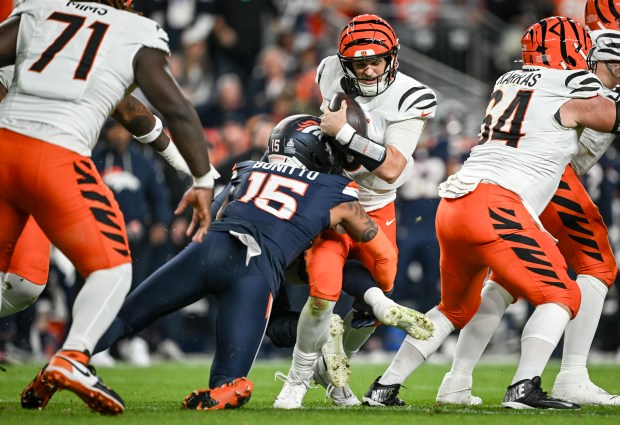 Nik Bonitto (15) of the Denver Broncos sacks Jake Browning (6) of the Cincinnati Bengals during the second quarter at Empower Field at Mile High on Monday, Sept. 29, 2025. (Photo by AAron Ontiveroz/The Denver Post)
Nik Bonitto (15) of the Denver Broncos sacks Jake Browning (6) of the Cincinnati Bengals during the second quarter at Empower Field at Mile High on Monday, Sept. 29, 2025. (Photo by AAron Ontiveroz/The Denver Post)
While on the subject of Bonitto’s new contract, there’s an interesting wrinkle that’s become more common with the Broncos and teams around the league: Bonitto got a $22 million signing bonus in 2025 and then a $14.03 million option bonus for 2026. That allows the team to prorate out money further. After that, the team is using an option structure in each subsequent contract year that helps create cap flexibility and keep Bonitto’s cap numbers in check later into the contract. Bonitto has base salaries at the league minimum on the books through 2029, the final year of the agreement, and then dummy years on the deal out through 2039, according to NFL Players Association data.
Denver’s done similar, though not exactly the same, with other recent contract extensions, including those given to DL Zach Allen and LT Garett Bolles.
Bolles originally had a low base salary for this season, but now NFLPA data shows it at $10.235 million, bumping his cap number for this season up from $5.8 million to $13 million. That’s likely because of the way Denver chose to pay option bonus amounts over the course of the year to him. Option bonuses can give teams choices, essentially, on whether to count guaranteed money (it’s going to the player one way or another by a certain date) as base salary, roster bonus or signing bonus.
Philadelphia did this with Jalen Hurts’ extension in 2023 and is among the most frequent users of the yearly option bonus structure in the NFL. It’s something the Broncos under GM George Paton and VP of football administration/cap guru Rich Hurtado have deployed more frequently recently.
Currently, OvertheCap shows Bonitto’s future cap figures like this.
2025: $5.85 million
2026: $8.42 million
2027: $13.62 million
2028: $17.6 million
2029: $22.65 million
2030 (void year): $45.55 million.
Those numbers will likely change as the contract progresses based on the way the options are structured, but it achieves the same thing for Bonitto and the Broncos: Strong guarantees in the deal at $70 million total, but also as-you-go cap management for the team.
By the time the final years of Bonitto’s deal arrive, the sides will either be preparing to come back to the table for another or looking to move on.
But that’s a conversation for another year. Bonitto looks like he’s got a whole lot of sacks to rack up between now and then.
5. Reserve WR Trent Sherfield sounds like a big brother when he talks about the strides rookie WR Pat Bryant is making and the pride he takes in the run game.
Sherfield has gone out of his way to take Bryant under his wing in part because Bryant was a college teammate of Caleb Griffin, who grew up in Sherfield’s hometown of Danville, Illinois.
“They’re two of the exact same people,” Bryant told The Post. “That’s why (Sherfield) and I mesh so good.”
Bryant’s been playing well, too.
He’s seen his playing time tick up in recent weeks, and in each of the Broncos’ past two games, his work in the blocking game has helped create a big play.
Last week, he busted Dobbins loose on a big run.
Monday night, he jumped down to the inside and walled off Bengals safety Geno Stone, allowing Marvin Mims Jr. to capture the edge and explode up the sideline for a 16-yard touchdown.
That’s impact, even if Bryant only had one target and didn’t catch a pass.
“It means a lot,” said Sherfield, who once was a young receiver learning from a great in Arizona. “I had that opportunity from Larry (Fitzgerald), just teaching me and passing it down to me. I’ve realized in my 8-year career that a lot of guys don’t have that type of leadership in the room. So it’s always good and Pat’s always eager to learn. …
“The other thing, too, what’s really cool about it is he’s a third-round pick. A lot of young receivers are not blocking like that. It’s only just going to — when the passing game opens up for him, he’s just going to get better and better.”
Sherfield’s not the only one paying attention, either. Players across the offense say that a receiver creating a big play with a block is a highlight.
“It gets me fired up,” Meinerz said. “We let them know when we see it on tape. It shows up. … When we watch the tape and we see a receiver blocking his tail off, we all make sure to give an extra ‘Hey man, love what you’re doing in the run game.’ It gets more runs called for us, and it makes the passing game that much easier. It really just works together.”
6. Talanoa Hufanga only had one tackle Monday night, but his impact in the secondary has been felt throughout the early part of the season and was again as the Broncos put the clamps on Cincy’s terrific receivers.
Payton described Hufanga this summer as a “first-responder,” and that jumps out when watching him play. Doesn’t matter if you’re in the stands, watching on television, looking down from the press box or even lined up right next to him.
“He’s all over the place,” running mate Brandon Jones told The Post recently. “Any time I look over — I thought I played fast, but he’s like, ‘Oh, there goes Huf. There goes Huf.’ It’s awesome.”
What isn’t as easy to see, though, is that for all the hair-on-fire play once the ball is snapped, Hufanga is exactly the opposite between plays.
“He’s a calm communicator, which is huge for a defense,” secondary coach Jim Leonhard told The Post recently. “He’s black and white, and that settles people down. Then he’s emotional and he’s a playmaker and he plays fast and physical. … Not everybody can do that. He has that ability to communicate pre-snap and think, and then he just turns it off. Then just react to what you see.”
Hufanga and Jones play left and right rather than strong and free – Jones and P.J. Locke did the same last year — and they have the latitude from Joseph and Leonhard to make decisions between them as long as they take care of all their collective responsibilities each play.
“Communication-wise, we’re both on the same page at all times,” Jones said. “But it also doesn’t get super serious. We’re able to joke around and stuff between plays, which is cool because if you’re relaxed, you can play fast, and football is fun at the end of the day.”
That was on display Monday night. After the Bengals drove for a field goal on their opening drive, they didn’t sniff points again the rest of the night.
Ja’Marr Chase: Five catches for 23 yards. Tee Higgins: three for 32. The biggest liability for the Broncos so far this season has been dealing with running backs and tight ends. RB Chase Brown had three catches for 31 and TE Mike Gesicki one for 8.
Overall, quarterback Jake Browning attempted 25 passes and ended up with 125 passing yards.
That’s a credit to everybody, but certainly in part to Hufanga and Jones.
“When you have two safeties you feel like can do both, you’re not trying to hide them or move them,” Leonhard said. “Everything you’re able to do as a staff is just to emphasize and feature the skills they do have rather than trying to hide (weaknesses). Over the course of a season, the more film you watch, those are the things that jump out when somebody is game-planning you. If you’re trying to hide somebody, they’re going to go, ‘OK, we’ve just got to find him or we’re going to try to get to certain things.’
“When you have two players, you can just play left and right. You don’t worry about the flow of a game and trying to take care of somebody. Your tendencies disappear, and you’re allowed to just call. You look at the call sheet and you’re not seeing things and saying, ‘Oh, I don’t want to call this. I don’t want to call that.’ It frees things up for Vance to just call what he thinks is right and trust that the matchups are going to be OK.'”
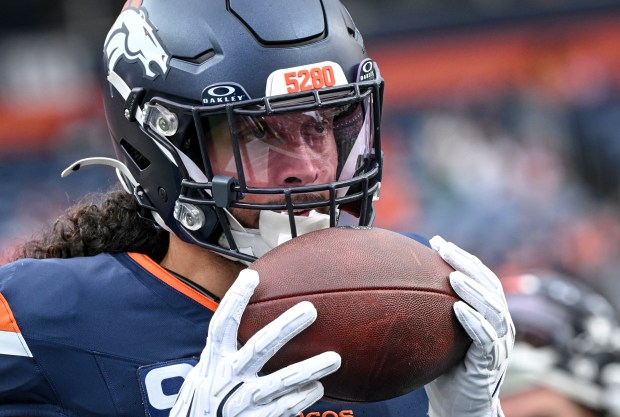 Talanoa Hufanga (9) of the Denver Broncos warms up before the game against the Cincinnati Bengals at Empower Field at Mile High on Monday, Sept. 29, 2025. (Photo by AAron Ontiveroz/The Denver Post)
Talanoa Hufanga (9) of the Denver Broncos warms up before the game against the Cincinnati Bengals at Empower Field at Mile High on Monday, Sept. 29, 2025. (Photo by AAron Ontiveroz/The Denver Post)
The Broncos eyed Hufanga as a potential free agent for a long time before actually landing him with a three-year deal this spring.
Still, once a player is actually in the building, it takes time to learn what he can do, how he learns, what he likes and doesn’t like.
Leonhard said those questions were perhaps more acute with Hufanga because of two factors: He’d missed 17 of 34 games over his last two years in San Francisco with multiple injuries, and he’d only played in one system, which Leonhard described as very effective but also, “a little more straightforward. There’s maybe not as much volume in what they do, so he got really, really good at what he was asked to do.”
That meant Hufanga spent a good chunk of the offseason not just learning a new system, but getting poked and prodded by his new coaches and running mate Jones.
“Any time you change systems like that, it raises the questions of, ‘OK, can he do this?’ Because you didn’t see it a lot on tape. Can he do that? How comfortable is he communicating this?” Leonhard said.
“We found out really, really early that it doesn’t matter what you ask him to do or where you ask him to play. He can handle it.”
7a. Much will be made about the Broncos offense after MNF, but this was as dominant a performance as you’ll see from the Denver defense.
The statistics are mind-boggling.
Cincinnati got the ball first to start the night and marched 62 yards over 12 plays, picking up four first downs and converting a pair of third downs before settling for a field goal.
After that, the Bengals offense did almost nothing.
Browning and company did not convert a third down the rest of the night, missing on their final eight tries.
The Bengals punted on each of their final eight full possessions, only mustered multiple first downs on a drive once, and tallied just five total.
In the final 54:08, Cincinnati snapped the ball exactly once from Denver territory, and it didn’t even count as a play because Ted Karras was whistled for holding and the ball got pushed back to the Cincinnati 46-yard line.
The longest rushing play Denver gave up in the game: 6 yards.
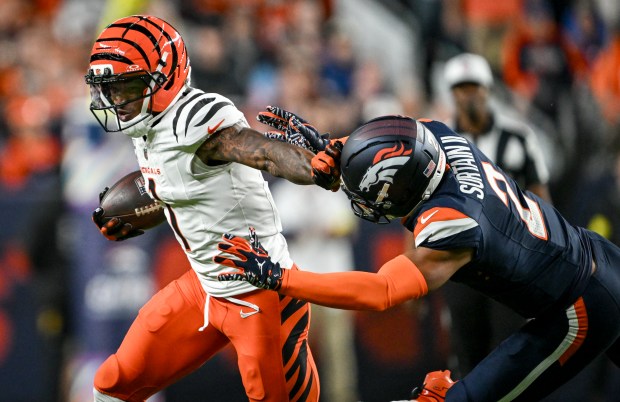 Ja’Marr Chase (1) of the Cincinnati Bengals stiff arms Pat Surtain II (2) of the Denver Broncos during the second quarter at Empower Field at Mile High on Monday, Sept. 29, 2025. (Photo by AAron Ontiveroz/The Denver Post)
Ja’Marr Chase (1) of the Cincinnati Bengals stiff arms Pat Surtain II (2) of the Denver Broncos during the second quarter at Empower Field at Mile High on Monday, Sept. 29, 2025. (Photo by AAron Ontiveroz/The Denver Post)
7b. Chalk up another win for Pat Surtain II, the reigning defensive player of the year, against Ja’Marr Chase.
Surtain got called for holding on the first play of the game and got a timely pass break-up from Jones on what might have been a big play, but otherwise held Chase to a quiet night once again.
Surtain’s rookie year in 2021, Chase had one catch for 3 yards, and it was not with Surtain in coverage.
Last year, with Surtain as the nearest defender, Chase had three catches for 27.
On Monday night: One catch for 8 with Surtain in coverage and just five for 23 overall.
So, in three matchups, Surtain has had coverage responsibility on 54 Chase routes, per NGS. Chase has four catches for 35 yards.
That’s quite a track record for Surtain against the best of the best.
Want more Broncos news? Sign up for the Broncos Insider to get all our NFL analysis.
Originally Published: September 30, 2025 at 4:30 AM MDT
